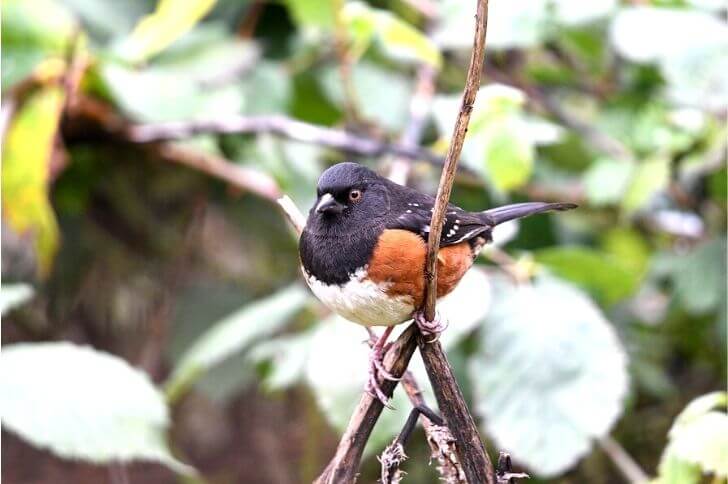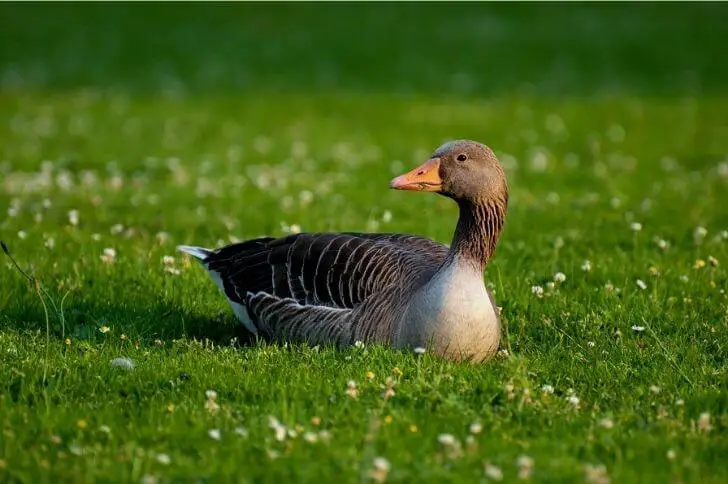Michigan is known for its abundance of beautiful birds, including black and white birds. Some common birds include the black throated gray warbler, downy woodpecker and dark eyed juncos.
The article below is perfect for any new birder or seasoned birding enthusiast in Michigan. We’ll look at different birds, their favored habitats, feeding habits and more.
List of Black and White birds in Michigan
1. Black throated gray warbler
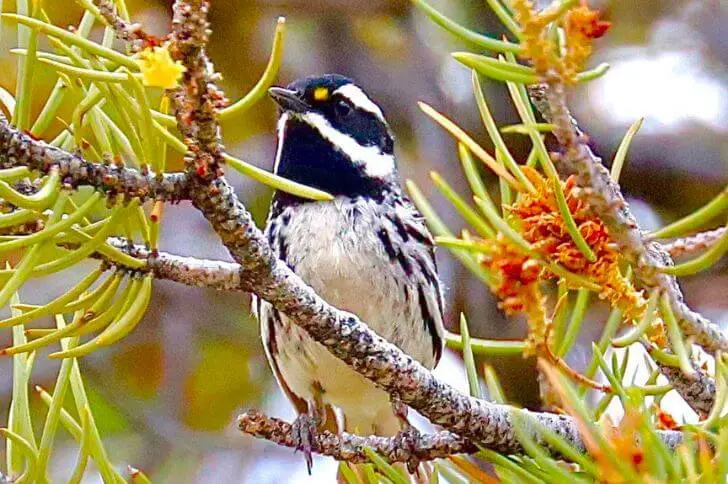
Black throated gray warblers are small songbirds that are found in eastern North America. This warbler is the most common warbler in the east, and can be found in a variety of habitats including forests, woodlands, and gardens.
These birds are active and vocal, and can often be seen foraging for insects on the ground or in trees. Male black throated gray warblers have a black throat, white eyebrow with a yellow spot at the front and white belly.
Females are duller with a less distinctive throat. What sounds do these bird species produce? The song of these backyard birds in Michigan is a series of “zeedle” sounds. On average this small birds have a lifespan of 6-10 years.
2. Downy woodpecker

Spotted a white and black bird in your backyard? There are different species of woodpeckers spotting similar plumage with minor differences that help tell them apart.
The Downy woodpecker is a small, common woodpecker in Michigan. These birds are black and white, with a red patch on the back of their heads. They have short, straight bills compared to their cousins.
This bird species uses their stiff tails for support as they climb up trees. Downy woodpeckers feed on insects, which they extract from tree bark or crevices in the wood. They are also known to store food in holes they excavate in trees.
3. Dark eyed juncos

Slightly larger than the house sparrow, dark eyed juncos are small black and white michigan birds that typically live in deciduous forests and open areas such as fields and meadows, but they can also be found in forests and urban areas.
Dark eyed juncos are also easy to spot in backyards and parks. So, how can you identify them?Be on the lookout for small birds, about 5-inch. Males are dark gray (almost black) with a pale belly and pinkish bill.
Female juncos spot a black head and brown back and pale underneath. These birds are very adaptable and can survive in a wide variety of habitats. These birds are very active and often sing loudly from high up in the trees. Their songs include warbles, trills, and whistles which you can hear from a distance.
Dark eyed juncos eat a variety of things, including seeds, insects, and fruit. They are known for being very agile climbers, and they often build their nests on the top of trees or other tall objects.
4. Ross’s goose
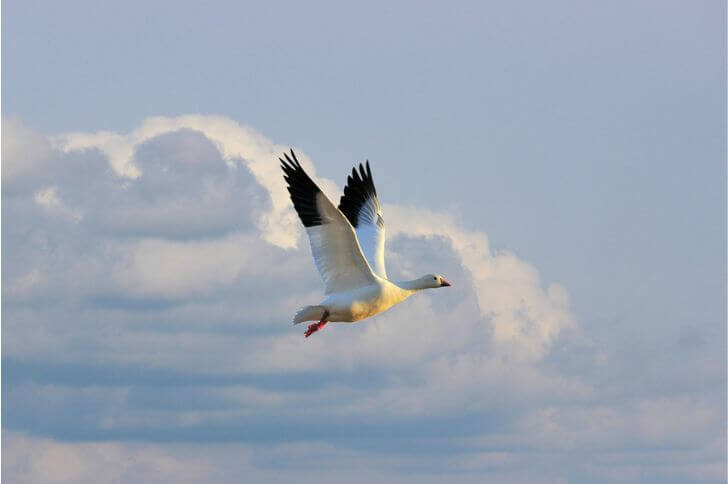
Ross’s goose or the Anser rossii is part family anatidae which includes other waterbirds in North america. It is a large bird, measuring up to 25 inches in length and weighing up to 3.5 lb. Juveniles are mostly white with gray highlights on their backs.
As they become older they’ll either become white with a black tail or have a white head black-gray body and white undertail. Their bills are reddish.
The Ross’s goose is a migratory bird, breeding in the tundra of northern Canada and Alaska. It winters in southern Canada, the United States, Mexico, and Central America. Ross’s geese form monogamous pairs for life and return to the same nesting areas each year.
Their clutch consists of 2-5 white eggs.
5. Common eider
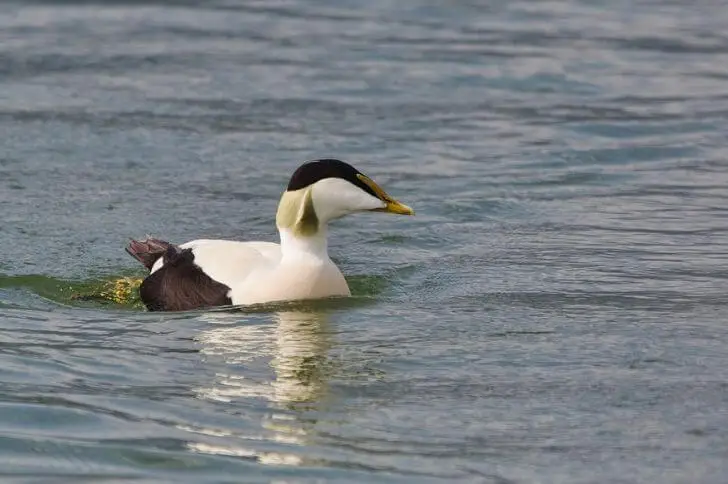
The common eider is a large sea duck that is found in parts of Michigan. Males are easily recognized by their black and white plumage with black cap, while the female is predominantly brown.
The common eider is a migratory bird, spending the winter in coastal waters where it feeds on fish and crustaceans. In the spring, the common eider returns to its breeding grounds where it builds nests of grass and down near water.
The eggs are incubated by the female, and the chicks are cared for by both parents. Their sounds include harsh “kor-kor”.
Related Read: Check black and white birds in Ohio
6. Eastern kingbirds

With the average length of 9.1 inches, Eastern kingbirds are one of the most common birds in the eastern United States, especially Michigan. They can be found in a variety of habitats, including forests, fields, and marshes.
These birds are known for their aggressive behavior and their ability to catch insects in midair. Eastern kingbirds typically build their nests near the top of trees or on telephone poles.
To identify an eastern kingbird, be on the lookout for a mid-sized bird with a black hood, dark gray back and white underneath. Their tails are also black with white tips.
7. Black-capped chickadee

Swift and melodious, black capped chickadees are awesome to listen to and are common backyard birds in most areas around the state. It is a small, sparrow-sized songbird that is found in forests, woodlands, and even urban areas. The black capped chickadee is easily recognizable by its black cap and white cheeks. It is a very vocal bird, and can be heard singing its characteristic “chick-a-dee-dee-dee” song year-round.
8. Laughing gull
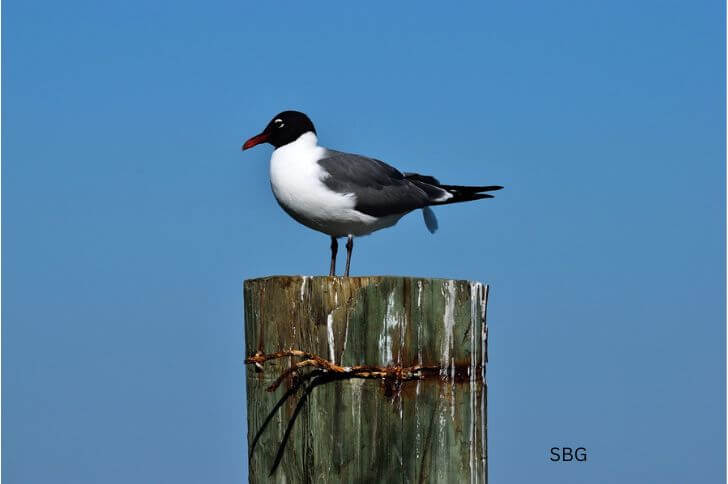
Laughing gulls are small gulls that are found in coastal areas in North America and the Caribbean. These birds are easy to identify because of their distinctive call, which sounds like laughter.
Laughing gulls are white with black markings on their head and wings, and a gray back. They have a red bill and dark gray legs. These birds can be seen flying or perched on sandbars, docks, or seawalls.
Laughing gulls eat fish, crustaceans, and insects. They often follow fishing boats to scavenge for food. These birds also steal food from other animals. Laughing gulls build nests out of seaweed, sticks, and grasses. They lay two to four eggs in the nest.
9. White-breasted nuthatch

Though these birds in Michigan are not do not fit the bill to a tee, we’ve included them on this list because they have some of this plumage on their feathers.
White-breasted nuthatch are a small, stocky bird that ranges in color from light gray to black, with a white chest and belly. It has a slightly long, pointed bill and a black cap. Note the chestnut undertail patch.
White breasted nuthatches The white-breasted nuthatch is active during the day, spending most of its time foraging for insects on tree trunks and branches. It also eats seeds and nuts. Nuthatches are known for their ability to climb head first down trees, an attribute that helps them find food in tight spaces.
10. Red-bellied woodpecker
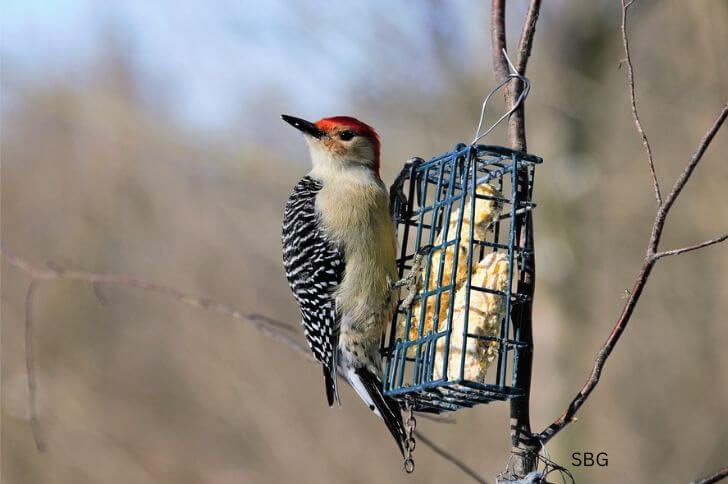
Red-bellied woodpeckers are medium-sized woodpeckers found across Michigan. The bird is generally barred, black and white, on the upperparts with a white face, but has a reddish belly. It has a long, straight bill and zygodactyl feet.
These black and white birds of Michigan prefer medium to large trees, mostly pines and hardwoods, where they build their nests in the tree cavity, and lay 4–5 eggs.
The white eggs take about two weeks to hatch with woodpecker babies coming out blind and naked. They’ll need their parent’s help for the first few weeks of their lives, being fed mostly on insects and other proteins.
What are the calls of the red-bellied woodpecker? Mostly drumming sound because of constant drilling sound but are also known for a loud ‘churr’ sound. If you have a few bird feeders in your yard, you can attract this bird with sunflower seeds. Check other white breasted birds
11. Black-headed gull

Slightly larger than the common crow, the black-headed gull is a common sight in coastal areas of Michigan. These migrant birds are about 14.6 inches long and have gray wings, a white body, and a black head.
They boast of a 43-inch wingspan and are known to feed on fish, insects, and other small animals. Black-headed gulls nest in colonies, lay speckled eggs in nests made of grasses or other materials, and incubate the eggs for about three weeks.
What is unique about these black and white birds in Michigan is their breeding habits. After the eggs hatch, parents are known to immediately remove the shells. Researchers believe the parents do this to either protect the remaining unhatched eggs or to throw-off predators.
Also males chicks are often the first to hatch but have a lower survival rate compared to female black-headed gull babies.
12. Hairy woodpecker
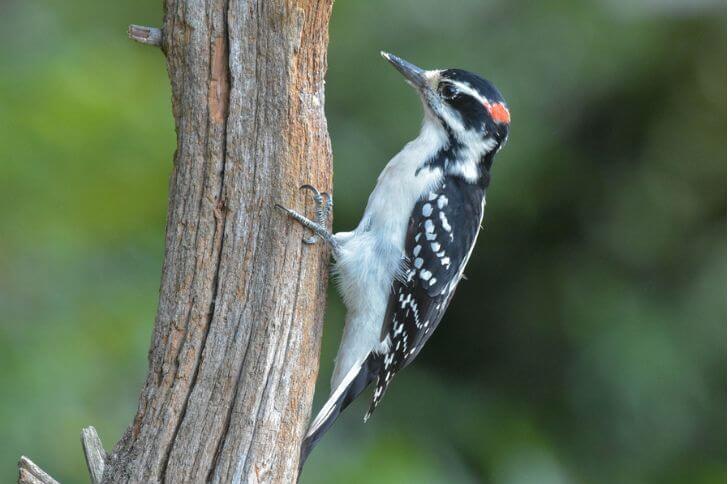
Another stunning group of black and white birds in Michigan are the hairy woodpeckers. At almost the same size as blue jays, hairy woodpeckers are medium-sized black and white woodpeckers.
They are easy to spot. Male hairy woodpeckers spot black wings, white head stripes, and a red patch at the back of their heads. On the other hand females share the same plumage without the red head patch. Both sexes spot white bellies.
These birds have a short, pointed bill. Hairy woodpeckers can be found in suburbs, forests and parks across Michigan. They eat insects, acorns, and other nuts. Hairy woodpeckers use their sharp bills to drill into tree trunks in search of insects. They also use their bills to hammer out holes in dead trees where they store food for later.
13. Northern flicker

A show stopper! The northern flicker is a stunning Michigan bird that you can easily attract to your backyard. This is slightly larger than a blue jay, measuring up to 12 inches with a wingspan of 16 – 20 inches.
This bird is easily recognizable by its pale brown color, bright yellow underwings, and spotted undertail. The gorgeous color combo makes them stand out from other birds in Michigan.
Northern flickers feed on insects that they find by pecking at the bark of trees or probing the ground for grubs. They also eat seeds and fruits when available. Northern flickers are monogamous birds and both the male and female help to care for the young.
During the breeding season, Northern flickers lay 5-8 eggs that take about two weeks to hatch. Nesting period lasts for about three weeks.
14. Snow goose
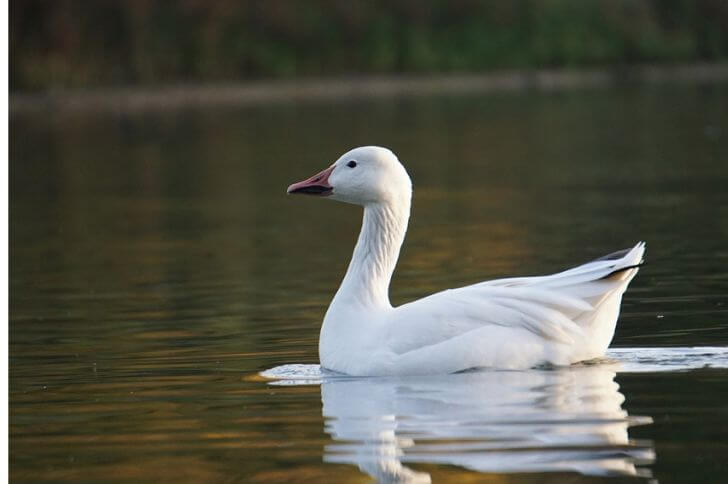
Loud. Very loud. Most people have termed snow geese the loudest birds in the waterfowl world. Snow geese are a migratory bird that can be found in wetlands, ponds, ponds and even cornfields of Michigan. They are distinguishable. Adults morph into two distinct plumage.
An adult snow goose can either be all white with black wingtips on the tail or a black-blue morph with a white head. Both morphs spot red feet.
Snow geese feed on grasses, grains, insects, and crustaceans. Their population has increased in recent years due to conservation measures and they are now considered a nuisance by some farmers.
During breeding season, these white and black birds of Michigan lay 2-6 large oval eggs that take up to three weeks to hatch. Nestling lasts a record one day. Unlike other chicks, snow geese babies are able to feed themselves and swim by day two but will stay with their family for up to two years for protection.
15. Spruce grouse

Fool hen or spruce hen or the spruce grouse is a medium-sized bird of the grouse family. It is a resident of Michigan, where it inhabits boreal forests.
This grouse is the smallest North American grouse. It measures about 15 inches in length and weighs about 18 oz. In comparison the largest grouse in America, the greater sage-grouse can weigh up to 7 pounds.
The plumage is cryptic, consisting of mottled gray and brown feathers, for females,that allow it to blend in with the forest floor. Males are darker with more black and white feathers.
The diet of the spruce grouse consists mainly of conifer needles and buds. During winter, when other food sources are scarce, the spruce grouse also eats small amounts of fruit and insects.
Male spruce grouse do not stick to one partner during breeding season. Their calls are known as cantus and consist of nasal sounds and low croaking when in conflict.
16. American coot

I think the American coot deserves to be on this list because of its black body and white bill. This black and white Michigan bird species is larger than a blue jay but smaller than a raven, measuring about 16 inches long.
American coots nest in colonies and can be found near ponds, lakes, and other wetlands. They are omnivorous and eat a variety of things, including plants, insects, small fish, and crustaceans.
They are known for their unique vocalizations, which include a variety of squawking and croaking noises. American coots typically live around 8 years in the wild. American coots lay up to 12 buff-gray speckled eggs or pinkish buff eggs per breeding season
17. Dovekie

Dovekies or little auks are small seabirds that are about 7-9 inches long and have a wingspan of about 15 inches. Dovekies have a black back, white underparts, and characteristic white wing bars. These black and white birds in Michigan are known to nest on cliffs and rocky islands. They feed mainly on small fish, but also eat crustaceans and other invertebrates.
Dovekies are social birds that usually travel in pairs or small groups and lay 2-3 bluish-green eggs.
18. Thick-billed murre
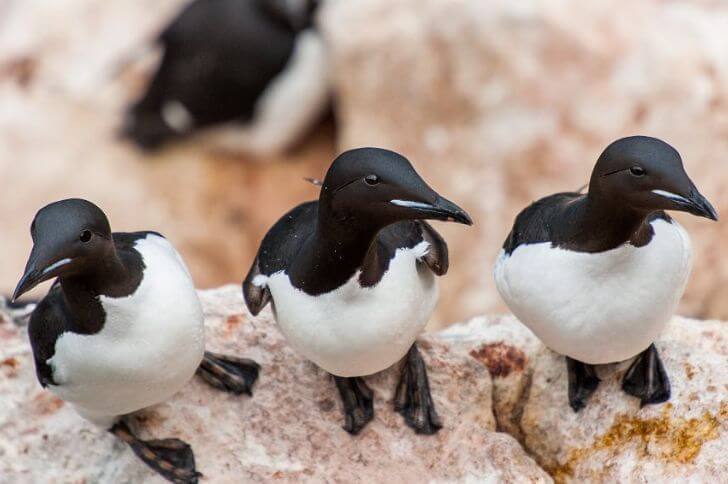
Stocky with a short-rounded tail, the thick-billed murre is a seabird in the genus Uria. It is also known as Brünnich’s guillemot. This bird is a medium-sized black and white seabird with a large, thick, bill.
It breeds in large colonies on coastal cliffs. The female lays a single egg, which she incubates for about 40 days. After hatching, the chick stays with its parents for up to six months until it can fly and fish on its own.
19. Yellow-billed loon

Measuring up to 38 inches in length and with a dagger-like bill, yellow-billed loons are large, aquatic birds that are found in parts of Michigan. It is the only species of loon that has a yellow bill.
These black and white birds in Michigan are known for their graceful swimming and diving abilities, and they can stay under water for extended periods of time. They are also proficient flyers, and can often be seen flying high overhead. Yellow-billed loons eat fish and other aquatic creatures, and they build nests on the ground or in trees near water.
Do loons mate for life? Yellow-billed loons are known for their life-long bonds. During breeding season they lay two brown or olive eggs, incubation period lasting for up to three weeks.
20. Black-crowned night-heron
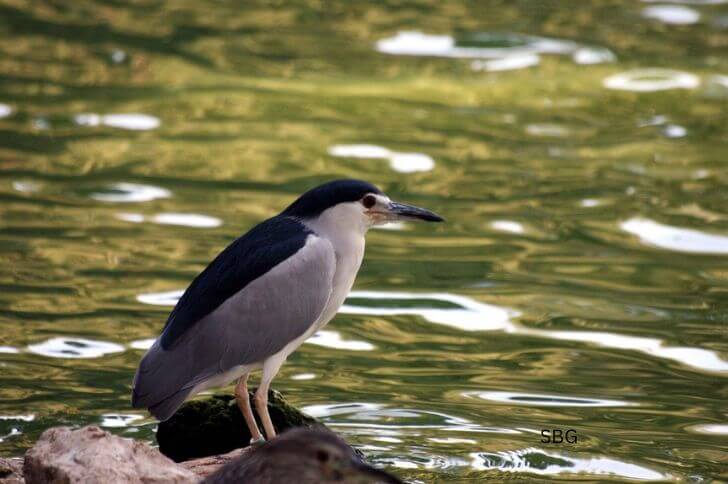
Are black-crown herons rare? These bird species are very common. Black crowned night heron is a medium-sized heron that is a highly mobile bird, capable of covering great distances in short periods of time.
Why are black-crowned night herons important? These birds feed on fish, helping to control their population. This heron can be distinguished from other herons by its tucked neck, black head and back, red eyes and white underparts. Juveniles are a streaky brown with a thick yellow bill. Note the brilliant yellow eyes.
These birds in Michigan typically found near bodies of water such as marshes, swamps, and lakes.
21. Black-capped vireo

Black-capped vireos are a small songbird species that is closely related to the warbler family. Its plumage is a mixture of olive green, yellow, white and black. Note the white mask around their red eyes.
The black-capped vireo is known for its distinctive “buzzy” song, which can be heard from a great distance.
Where can I find black-capped vireo? This bird is common in open oak woodlands and riparian habitats, where it feeds on insects and spiders. Is the black-capped chickadee endangered? In recent years their population has decreased due to habitat loss.
22. Northern shrike
Where do northern shrikes like? They can be found across the country and in Michigan they favor the boreal forest and migrate in winter. Adults have a gray back, white underparts, black mask and tail. Notice their black legs and their black hooked bill.
These backyard birds in Michigan measure about 9.4 inches with a wingspan of 14 inches. They prey on bugs, beetles, spiders and grasshoppers. Are northern shrikes raptors?
Unlike other birds of prey, northern shrikes do not have talons but they do feed on flesh, especially smaller birds such as the black-capped chickadee and common starling. They also prey on reptiles and mice.
23. Black-billed magpie

How big is a black-billed magpie? These black and white birds in Michigan are up to 23 inches long with a wingspan of about 24 inches.
The black-billed magpie or American magpie is a large songbird in the crow family, Corvidae. Magpies are gregarious birds, and often live in flocks of 10-50 birds. Where do the black-billed magpies like? You can find them in fields, along streams and are common in most backyards.
They are easily distinguishable with a black head and back, white underneath and iridescent blue on the wings and tail.
They are omnivorous, eating insects, worms, small mammals, eggs, and fruit. Magpies are also known for their intelligence and complex social behavior.
24. Eastern towhee

Striking and loners, eastern towhees are migratory birds that are easy to spot. Unlike other birds on this list, these birds prefer a solitary life, with males developing different tactics to chase away other males from their territory.
The adult male is black with a white wing bar, white belly and rufous sides. Females and juveniles feature a dark brown back, lighter sides, and white belly. Both sexes spot red eyes.
They are well known for their habit of scratching the ground with their feet to uncover food. Eastern towhees eat insects, seeds, and berries, and they can be found in a variety of habitats including forests, gardens, and backyards.
Eastern towhees are monogamous birds, meaning that they form pairs that stay together for life. These birds build nests out of twigs and leaves, and they lay between 3 and 6 eggs. The chicks stay in the nest for about 2 weeks before fledging. Also, cowbirds are known to lay their eggs in Eastern towhee’s nests; brood parasitism.
25. Sandwich tern
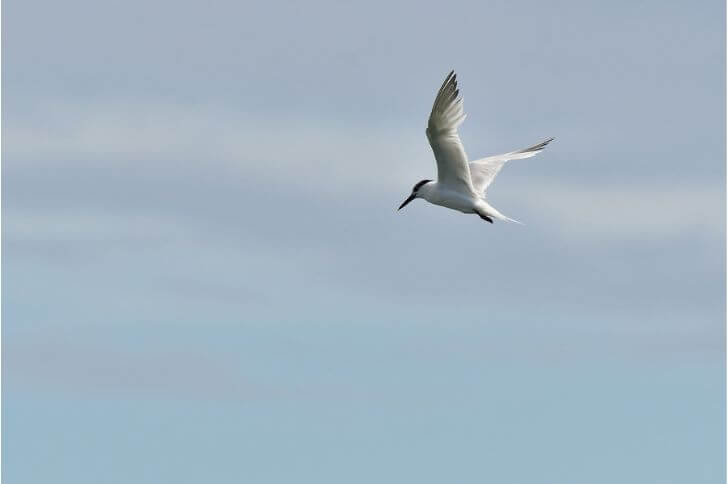
From the family laridae, sandwich terns are small seabirds that can be found in coastal areas of Michigan. These birds are usually between 13 and 17 inches in length, and they have long, pointed wings and a forked tail.
The sandwich tern feeds primarily on small fish, but they will also eat shrimp, crabs, and other marine creatures. These birds are very agile in the air, and they are able to fly long distances without stopping. Sandwich terns typically nest in colonies on sandy beaches or rocky cliffs, and they lay between two and four eggs per clutch.
Are sandwich terns migratory birds? Yes, during winter they move to warmer places like Florida. What do terns sound like? They are known for sharp “kirrik” and “pee-up” sounds.
26. Yellow-throated warbler
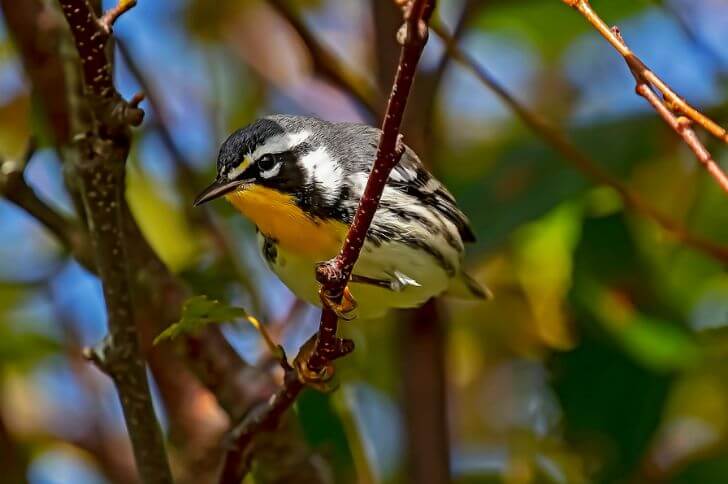
Large and melodious, the yellow throated warbler is a small songbird that can be found all-over Michigan. This warbler is easily recognizable by its bright yellow throat and chest and its black and white back. Notice its long sharp bill. It is a common bird, but can be hard to spot among the trees.
On average, the adult bird is about 5.5 inches with a wingspan of 8.3 inches. They are the same size as house sparrows. Is the yellow-throated warbler rare? Fortunately their numbers are stable. You can find them near water bodies.
Female yellow-throated warblers lay 4-6 eggs, which they incubate for about two weeks. The young yellow warbler fledges about two weeks after hatching.
The yellow throated warbler feeds on insects and spiders, which it catches while perched or flying.
These backyard birds in Michigan are a migratory bird, spending the winter in Central America and the Caribbean. In the spring, it returns to North America to breed.
27. Rose-breasted grosbeak
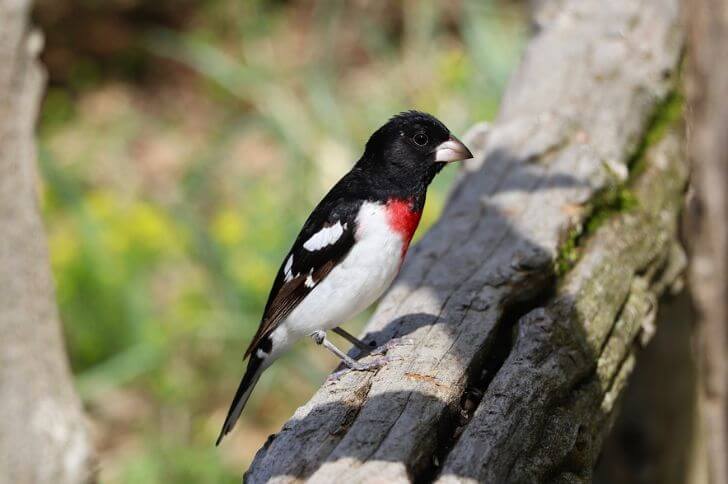
Rose breasted grosbeaks are beautiful birds that are about 8 inches long and have a wingspan of about 12 inches. They are mostly black with a white belly and red chest. The female is brown with white stripes on their head. They have a thick, triangular bill that is perfect for eating insects.
Rose breasted grosbeaks love to eat berries and seeds, and they can be found in wooded areas and gardens. They are usually seen singly or in pairs, but they sometimes form small flocks in the winter. These birds are very active and love to sing, and they are easy to recognize by their bright colors.
28. Black and white warbler
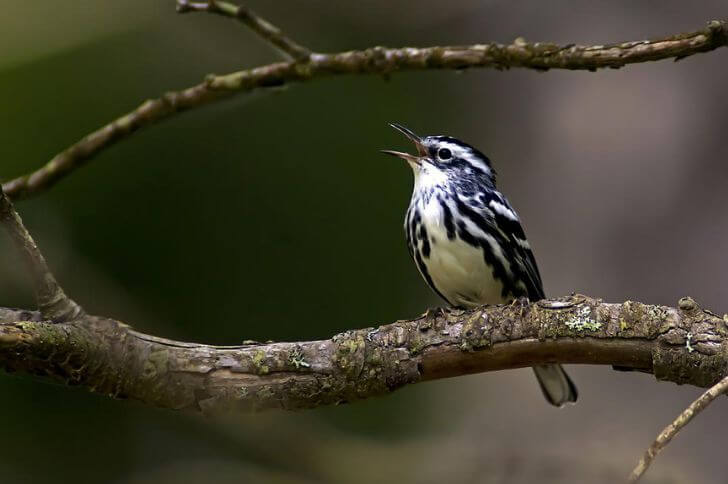
Black and white warblers are a beautiful Michigan bird that are easy to identify. The male of the species has darker plumage compared to the female. Both species have a striped white and black look with pointed beak.
These birds are found in woods near streams where they build their nests. They eat insects and spiders which they catch by flying out from their perches to snatch them from the air.
29. Eastern meadowlark
The eastern meadowlark is a beautiful songbird that is found in open fields and meadows across the State of Michigan. This bird is easily identified by its bright yellow breast and black V-shaped markings. The eastern meadowlark is known for its lovely singing voice, which consists of a series of flute-like notes.
This bird is typically around 10 inches in length, with a wingspan of up to 15 inches. The eastern meadowlark is an important part of the ecosystem, as it helps to control insect populations. This bird typically nests on the ground, in an area of tall grass or weeds.
The eastern meadowlark population has declined in recent years due to habitat loss and fragmentation. However, this bird still remains a common sight in many areas of Michigan
30. Pileated woodpecker
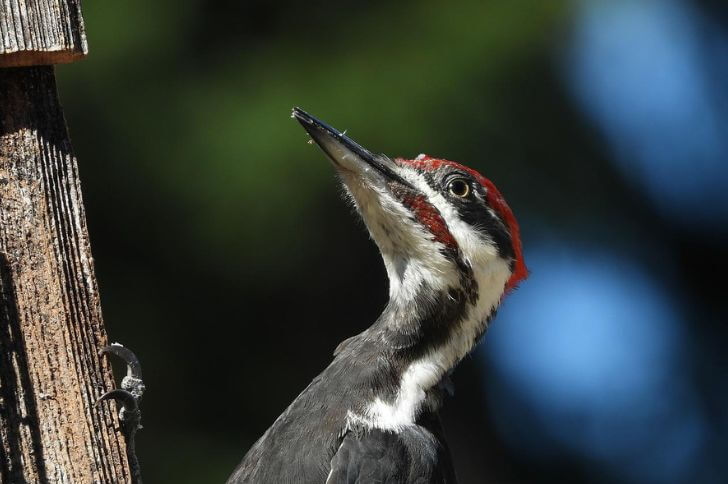
Pileated woodpeckers are one of the largest woodpeckers in North America, and they are known for their striking red crest. These birds are expert climbers and can often be seen scaling trees in search of food. Pileated woodpeckers eat a variety of insects, including ants, beetles, and caterpillars.
In addition to insects, these birds also eat nuts and fruits. Pileated woodpeckers play an important role in the forest ecosystem by helping to control insect populations. These birds mate for life and typically nest in tree cavities. If you’re lucky enough to spot a pileated woodpecker, you’re sure to be impressed by this magnificent bird!
31. Red-headed woodpecker
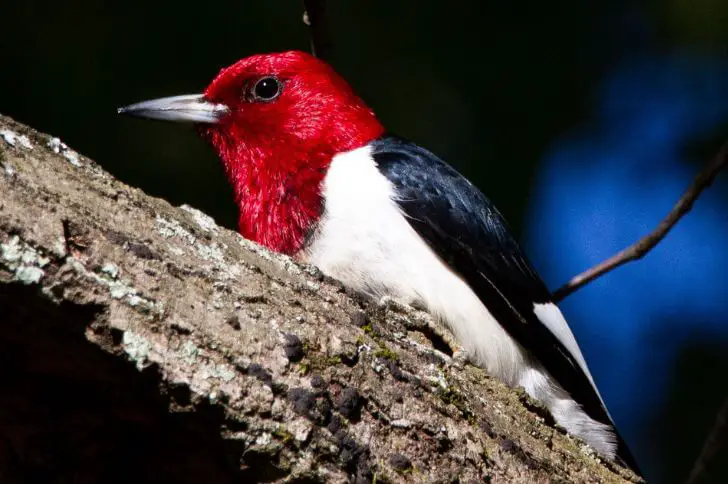
Why is it called a red-headed woodpecker? It gets its name from the bright red color on its head. These birds are not only beautiful to look at, but they are also interesting to watch as they use their long beaks to peck at tree trunks in search of food.
These woodpeckers are not very big, only reaching about 8-9 inches in length, but they make up for their size with their loud calls and vibrant plumage. Males and females look alike, with the only difference being that males have a redder head than females.
Red-headed woodpeckers can be found in woods or forests across Michigan. If you’re lucky enough to see one of these birds, you’re sure to be charmed by its beauty and intrigued by its behavior.
32. American black duck
Another group of black and white birds in Michigan are the American black ducks. It is a medium-sized waterfowl with a body length of 20 to 26 inches and a wingspan of 31 to 37 inches. The male black duck has a dark brown body with a paler head and a yellow bill. The female black duck has a darker shade of brown.
Both sexes have white underwings. The breeding habitat consists of marshes, ponds, and lakes with dense vegetation for nesting.
33. Tufted duck
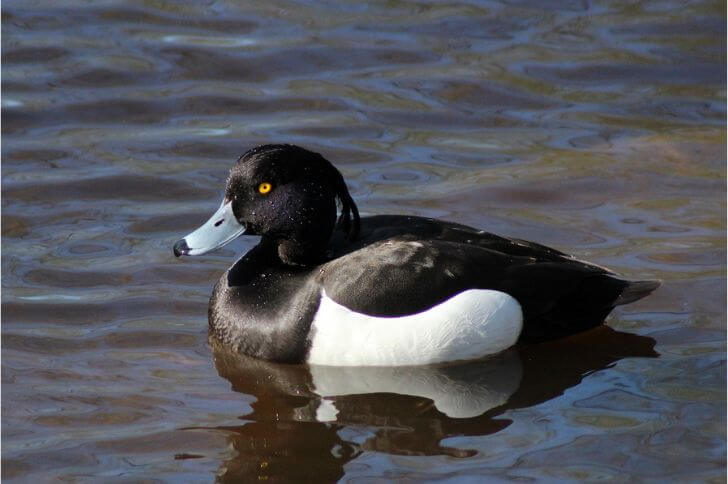
Tufted ducks are a medium-sized diving duck with a black head and back, white underbelly and underwings, and white wing bars. Both sexes have yellow eyes and grayish webbed feet.
The tufted duck is migratory, wintering in southern Europe, Africa, and southern Asia. It feeds on aquatic plants and animals. It dives for food, often staying underwater for long periods of time.
35. Black-necked stilt

Black-necked stilts are a species of shorebird that can be found in some parts of Michigan. The adult stilt has black upperparts and a white face, neck and underparts. The legs are long and pink, and the bill is long and black. The juvenile stilt has a grayish-brown neck and breast.
The black-necked stilt breeds in freshwater marshes. The nest is a shallow cup of vegetation lined with feathers. The female lays 3-4 eggs, which are incubated for 21-24 days. The young stilts fledge at 30-35 days old.
This bird gets its name from its long, thin legs, which look like they have been stretched out or “stilted”.
Hi, my name is Steve. My friend and I started the spanishbirdguides.com to share our passion with other like-minded people. So, if bird watching is your thing, you’ll love this blog. I’ll share what I’ve learnt about both local birds and those found in other parts of the world. Also, I’d love to hear your experiences.
